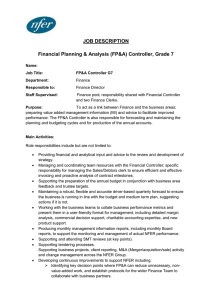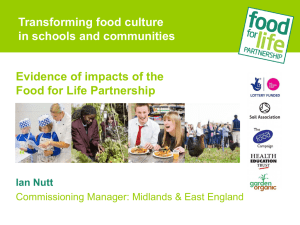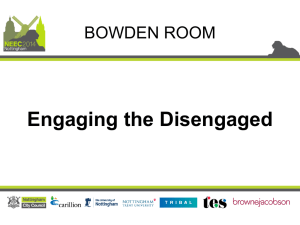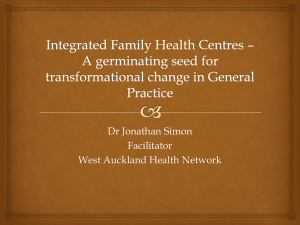645kb Powerpoint - Social Services Research Group
advertisement
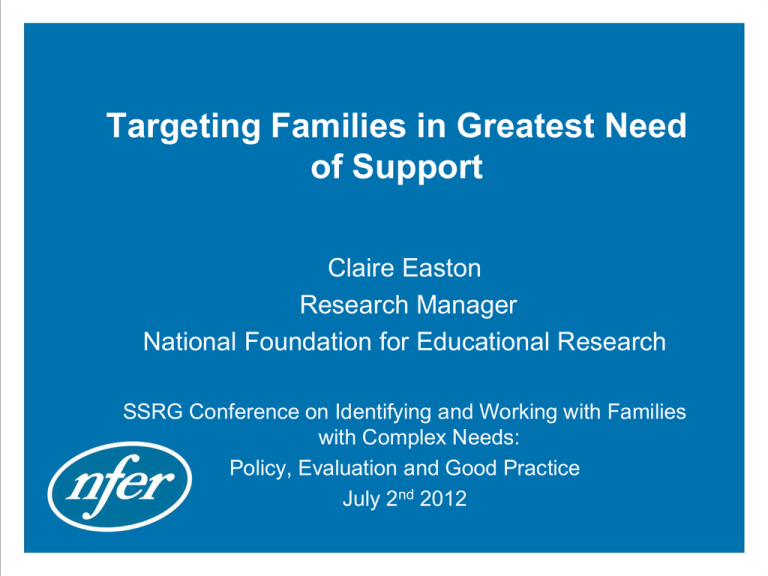
Targeting Families in Greatest Need of Support Claire Easton Research Manager National Foundation for Educational Research SSRG Conference on Identifying and Working with Families with Complex Needs: Policy, Evaluation and Good Practice July 2nd 2012 About the research Funded by the Local Government Association (LGA) To explore the different approaches which LAs and early years settings take to targeting support on the neediest families – through lens of Children’s Centres A rapid review of policy and research Case studies of 6 local authority areas: 47 interviews with LA and Children’s Centre staff, seven focus groups with staff from other Centres and services April to September 2011 2 3 1. Who are Children’s Centres targeting? Children (e.g. additional needs, speech and language delay, challenging behaviour) Parents (e.g. domestic violence, mental health, parenting issues) Families (e.g. worklessness, social isolation, poor housing) Groups (e.g. teen parents, lone parents, BME groups, dads) But Children’s Centres prefer to see their work as supporting children, parents and families, rather than targeting groups 4 2. How do they define ‘greatest need’? It is difficult to achieve a precise definition of ‘greatest need’. Children’s Centres tend to prioritise: Those facing multiple or severe challenges Parenting issues and children with additional needs Crisis prevention, early intervention and addressing child poverty (e.g. poor housing, adult skills and confidence) But Children’s Centres are also responding to local priorities and individual needs, with a case-by-case response 5 3. What data do they use? Geographical deprivation (postcode & area) Live birth data Partners’ data (e.g. health, social care, housing) CAF/TAC referral data CC engagement (monitoring data) Local needs analyses National/area data and trends But some face challenges in accessing key data incl. from health (e.g. live birth data) and social care (e.g. about families known to them) 6 4. How do they identify families? Share information across services (incl. drawing together multiple sources of information and interpreting data intelligently) Tools and models (e.g. early years entitlement model) Referrals & casework (esp. from health visitors) Early intervention approaches Outreach Local knowledge (incl. community entrepreneurs) But universal services remain key to reducing barriers and engaging vulnerable families 7 Examples of practice 1. Blue slips model – overcoming barriers to new birth data using ‘blue slips registrations’ 2. Engage first approaches – from stay and plays, to cooking clubs and community days, to formal initiatives such as PEEP 3. Community model – local parents trained to engage families through outreach (e.g. as ‘community entrepreneurs’) 8 5. How do they develop services for the most needy? Strategic decision-making Monitoring & review Consultation & feedback Identifying facilitators & barriers, incl. hidden needs LA support & challenge Assessing VfM, outcomes and impacts It’s a dynamic system - services need to ‘step down’ as well as ‘step up’ 9 Staff attitudes are key to understanding barriers ... ‘ There used to be a term “hard to reach”. But we don’t use it any more, because we recognise it’s us who are hard to reach, not the families ... If you’ve not got any confidence, or you think that they will tell you that you’re a bad parent – if that’s what’s preventing families engaging with us, we’ve got to try to reduce those barriers .’ (Centre manager) 10 Who are the ‘most needy’? Difficult to define precisely In practice, focus on children at Levels 4, 3 and 2 (windscreen model) But this does not include early intervention and ‘hidden needs’ This model focuses on children, not families What are the consequences for staff of dealing with families at higher levels of need? 11 Key issues and implications Identifying families in greatest need is a complex process Staff are keen to prevent stigmatising Universal services are key Language is important (‘supporting families’ rather than ‘targeting needs’) Some centres face difficulties in getting certain data Workforce and training implications for data management, evidencing impact and dealing with families with more complex needs 12 Further information on Targeting Families in Greatest Need of Support Published report is available at: http://www.nfer.ac.uk/nfer/publications/LGTC01/ Research contacts: Pippa Lord, Senior Research Manager p.lord@nfer.ac.uk Caroline Sharp, Research Director c.sharp@nfer.ac.uk 13 Other NFER publications and resources • • • • • • • LARC http://www.larc-research.org.uk LARC 4 explores the interface between CAF/TAC model and social care intervention to support children and families with complex high level needs Early intervention: informing local practice (Feb 2012) http://www.nfer.ac.uk/publications/LGLC02 Developing a business case for early interventions and evaluating their value for money (November 2011) http://www.nfer.ac.uk/publications/EITS01 The experiences of fostering and adoption processes – views of children and young people: literature review and gaps analysis (May 2012) http://www.nfer.ac.uk/publications/LGFR01 A good practice overview of fostering and adoption activity: case study reports http://www.nfer.ac.uk/publications/LGFP01 http://www.reason-network.org.uk/ resources, networks and support from research in practice, research in practice with adults, NFER Children’s Trust arrangements and Health and Wellbeing Boards following the Health and Social Care Act (to be published) Project coordinator contact: Sagina Khan s.khan@nfer.ac.uk 14
